CHEVROLET KODIAK 2007 Owners Manual
Manufacturer: CHEVROLET, Model Year: 2007, Model line: KODIAK, Model: CHEVROLET KODIAK 2007Pages: 430, PDF Size: 6.06 MB
Page 231 of 430
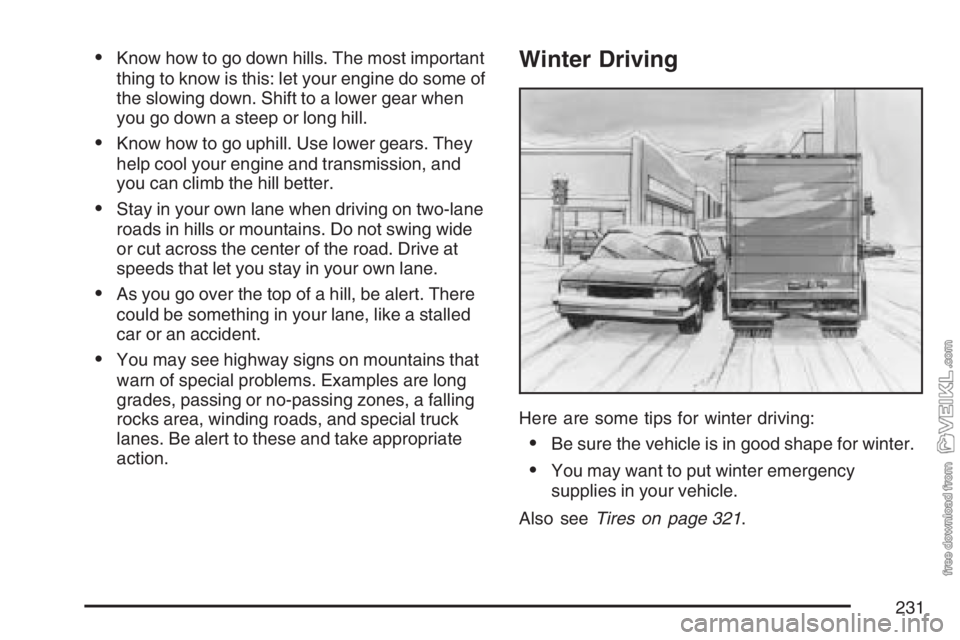
•Know how to go down hills. The most important
thing to know is this: let your engine do some of
the slowing down. Shift to a lower gear when
you go down a steep or long hill.
•Know how to go uphill. Use lower gears. They
help cool your engine and transmission, and
you can climb the hill better.
•Stay in your own lane when driving on two-lane
roads in hills or mountains. Do not swing wide
or cut across the center of the road. Drive at
speeds that let you stay in your own lane.
•As you go over the top of a hill, be alert. There
could be something in your lane, like a stalled
car or an accident.
•You may see highway signs on mountains that
warn of special problems. Examples are long
grades, passing or no-passing zones, a falling
rocks area, winding roads, and special truck
lanes. Be alert to these and take appropriate
action.
Winter Driving
Here are some tips for winter driving:
•Be sure the vehicle is in good shape for winter.
•You may want to put winter emergency
supplies in your vehicle.
Also seeTires on page 321.
231
Page 232 of 430
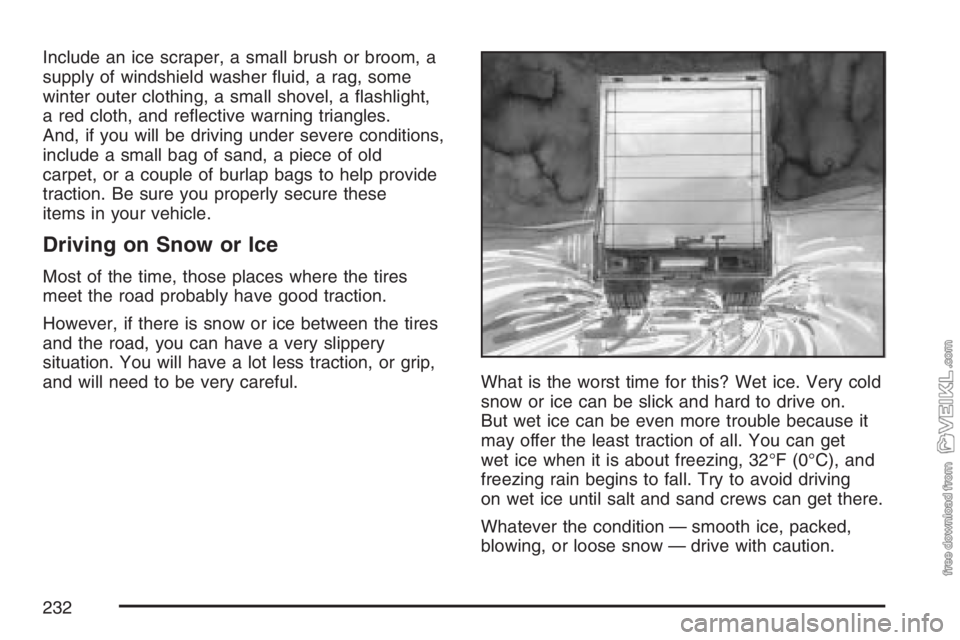
Include an ice scraper, a small brush or broom, a
supply of windshield washer fluid, a rag, some
winter outer clothing, a small shovel, a flashlight,
a red cloth, and reflective warning triangles.
And, if you will be driving under severe conditions,
include a small bag of sand, a piece of old
carpet, or a couple of burlap bags to help provide
traction. Be sure you properly secure these
items in your vehicle.
Driving on Snow or Ice
Most of the time, those places where the tires
meet the road probably have good traction.
However, if there is snow or ice between the tires
and the road, you can have a very slippery
situation. You will have a lot less traction, or grip,
and will need to be very careful.What is the worst time for this? Wet ice. Very cold
snow or ice can be slick and hard to drive on.
But wet ice can be even more trouble because it
may offer the least traction of all. You can get
wet ice when it is about freezing, 32°F (0°C), and
freezing rain begins to fall. Try to avoid driving
on wet ice until salt and sand crews can get there.
Whatever the condition — smooth ice, packed,
blowing, or loose snow — drive with caution.
232
Page 233 of 430
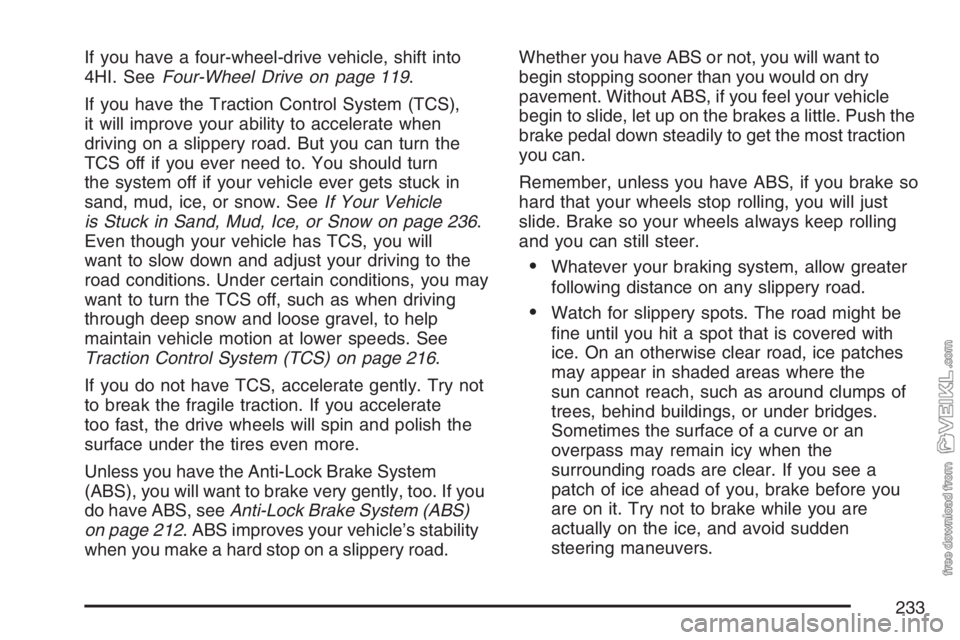
If you have a four-wheel-drive vehicle, shift into
4HI. SeeFour-Wheel Drive on page 119.
If you have the Traction Control System (TCS),
it will improve your ability to accelerate when
driving on a slippery road. But you can turn the
TCS off if you ever need to. You should turn
the system off if your vehicle ever gets stuck in
sand, mud, ice, or snow. SeeIf Your Vehicle
is Stuck in Sand, Mud, Ice, or Snow on page 236.
Even though your vehicle has TCS, you will
want to slow down and adjust your driving to the
road conditions. Under certain conditions, you may
want to turn the TCS off, such as when driving
through deep snow and loose gravel, to help
maintain vehicle motion at lower speeds. See
Traction Control System (TCS) on page 216.
If you do not have TCS, accelerate gently. Try not
to break the fragile traction. If you accelerate
too fast, the drive wheels will spin and polish the
surface under the tires even more.
Unless you have the Anti-Lock Brake System
(ABS), you will want to brake very gently, too. If you
do have ABS, seeAnti-Lock Brake System (ABS)
on page 212. ABS improves your vehicle’s stability
when you make a hard stop on a slippery road.Whether you have ABS or not, you will want to
begin stopping sooner than you would on dry
pavement. Without ABS, if you feel your vehicle
begin to slide, let up on the brakes a little. Push the
brake pedal down steadily to get the most traction
you can.
Remember, unless you have ABS, if you brake so
hard that your wheels stop rolling, you will just
slide. Brake so your wheels always keep rolling
and you can still steer.
•Whatever your braking system, allow greater
following distance on any slippery road.
•Watch for slippery spots. The road might be
fine until you hit a spot that is covered with
ice. On an otherwise clear road, ice patches
may appear in shaded areas where the
sun cannot reach, such as around clumps of
trees, behind buildings, or under bridges.
Sometimes the surface of a curve or an
overpass may remain icy when the
surrounding roads are clear. If you see a
patch of ice ahead of you, brake before you
are on it. Try not to brake while you are
actually on the ice, and avoid sudden
steering maneuvers.
233
Page 234 of 430
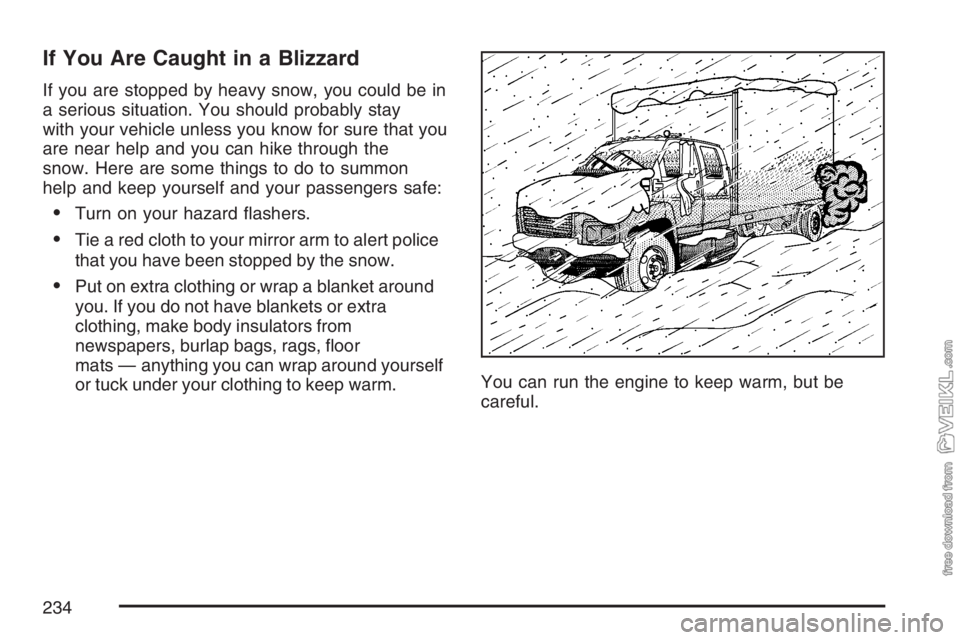
If You Are Caught in a Blizzard
If you are stopped by heavy snow, you could be in
a serious situation. You should probably stay
with your vehicle unless you know for sure that you
are near help and you can hike through the
snow. Here are some things to do to summon
help and keep yourself and your passengers safe:
•Turn on your hazard flashers.
•Tie a red cloth to your mirror arm to alert police
that you have been stopped by the snow.
•Put on extra clothing or wrap a blanket around
you. If you do not have blankets or extra
clothing, make body insulators from
newspapers, burlap bags, rags, floor
mats — anything you can wrap around yourself
or tuck under your clothing to keep warm.You can run the engine to keep warm, but be
careful.
234
Page 235 of 430
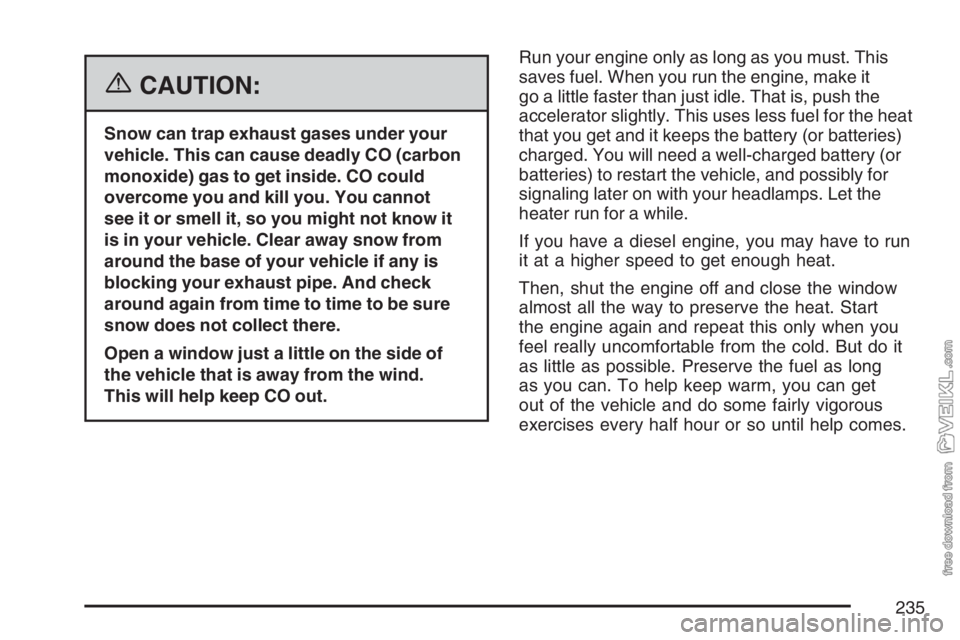
{CAUTION:
Snow can trap exhaust gases under your
vehicle. This can cause deadly CO (carbon
monoxide) gas to get inside. CO could
overcome you and kill you. You cannot
see it or smell it, so you might not know it
is in your vehicle. Clear away snow from
around the base of your vehicle if any is
blocking your exhaust pipe. And check
around again from time to time to be sure
snow does not collect there.
Open a window just a little on the side of
the vehicle that is away from the wind.
This will help keep CO out.Run your engine only as long as you must. This
saves fuel. When you run the engine, make it
go a little faster than just idle. That is, push the
accelerator slightly. This uses less fuel for the heat
that you get and it keeps the battery (or batteries)
charged. You will need a well-charged battery (or
batteries) to restart the vehicle, and possibly for
signaling later on with your headlamps. Let the
heater run for a while.
If you have a diesel engine, you may have to run
it at a higher speed to get enough heat.
Then, shut the engine off and close the window
almost all the way to preserve the heat. Start
the engine again and repeat this only when you
feel really uncomfortable from the cold. But do it
as little as possible. Preserve the fuel as long
as you can. To help keep warm, you can get
out of the vehicle and do some fairly vigorous
exercises every half hour or so until help comes.
235
Page 236 of 430
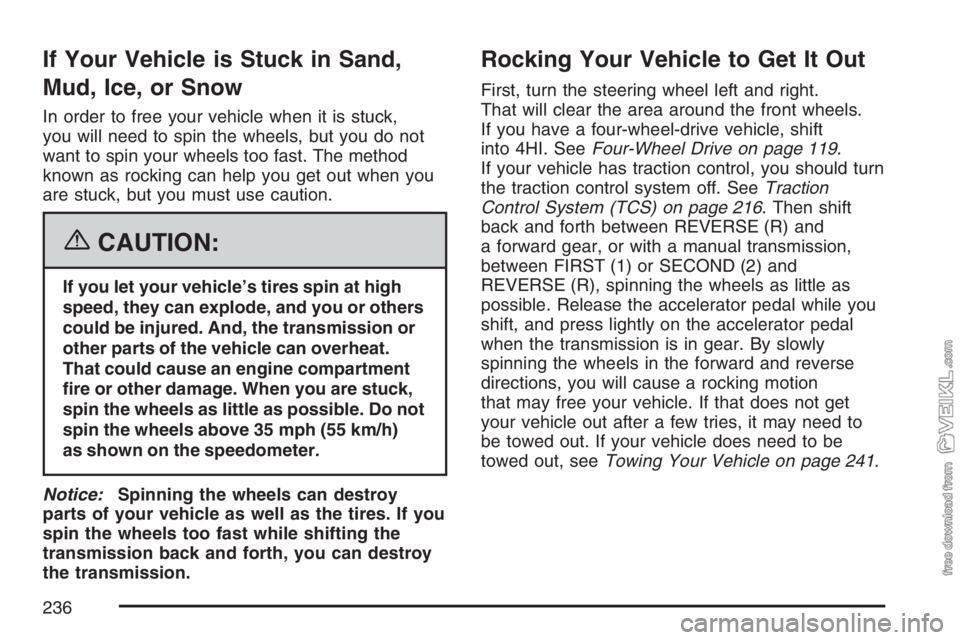
If Your Vehicle is Stuck in Sand,
Mud, Ice, or Snow
In order to free your vehicle when it is stuck,
you will need to spin the wheels, but you do not
want to spin your wheels too fast. The method
known as rocking can help you get out when you
are stuck, but you must use caution.
{CAUTION:
If you let your vehicle’s tires spin at high
speed, they can explode, and you or others
could be injured. And, the transmission or
other parts of the vehicle can overheat.
That could cause an engine compartment
�re or other damage. When you are stuck,
spin the wheels as little as possible. Do not
spin the wheels above 35 mph (55 km/h)
as shown on the speedometer.
Notice:Spinning the wheels can destroy
parts of your vehicle as well as the tires. If you
spin the wheels too fast while shifting the
transmission back and forth, you can destroy
the transmission.
Rocking Your Vehicle to Get It Out
First, turn the steering wheel left and right.
That will clear the area around the front wheels.
If you have a four-wheel-drive vehicle, shift
into 4HI. SeeFour-Wheel Drive on page 119.
If your vehicle has traction control, you should turn
the traction control system off. SeeTraction
Control System (TCS) on page 216. Then shift
back and forth between REVERSE (R) and
a forward gear, or with a manual transmission,
between FIRST (1) or SECOND (2) and
REVERSE (R), spinning the wheels as little as
possible. Release the accelerator pedal while you
shift, and press lightly on the accelerator pedal
when the transmission is in gear. By slowly
spinning the wheels in the forward and reverse
directions, you will cause a rocking motion
that may free your vehicle. If that does not get
your vehicle out after a few tries, it may need to
be towed out. If your vehicle does need to be
towed out, seeTowing Your Vehicle on page 241.
236
Page 237 of 430
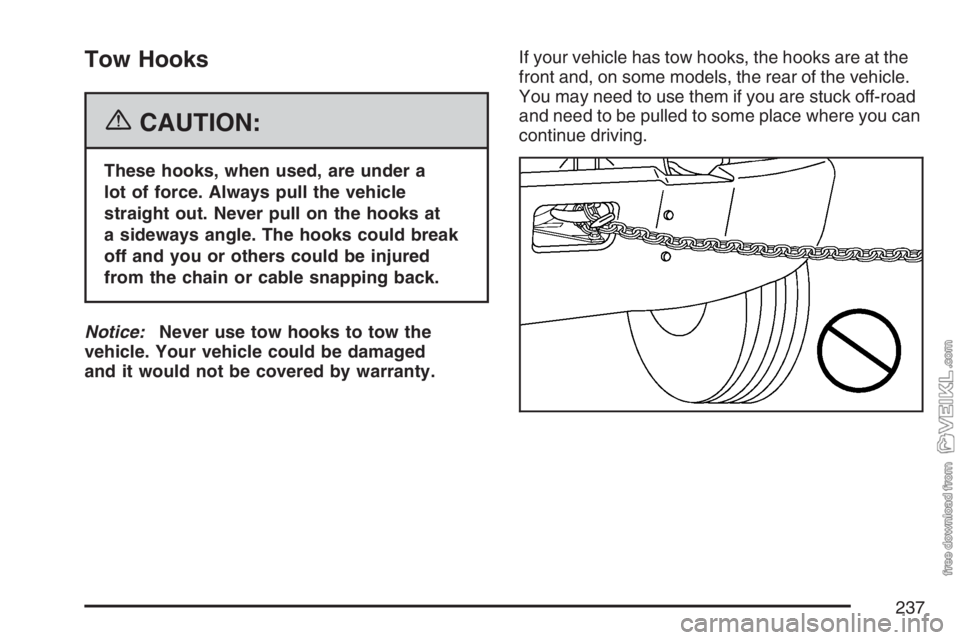
Tow Hooks
{CAUTION:
These hooks, when used, are under a
lot of force. Always pull the vehicle
straight out. Never pull on the hooks at
a sideways angle. The hooks could break
off and you or others could be injured
from the chain or cable snapping back.
Notice:Never use tow hooks to tow the
vehicle. Your vehicle could be damaged
and it would not be covered by warranty.If your vehicle has tow hooks, the hooks are at the
front and, on some models, the rear of the vehicle.
You may need to use them if you are stuck off-road
and need to be pulled to some place where you can
continue driving.
237
Page 238 of 430
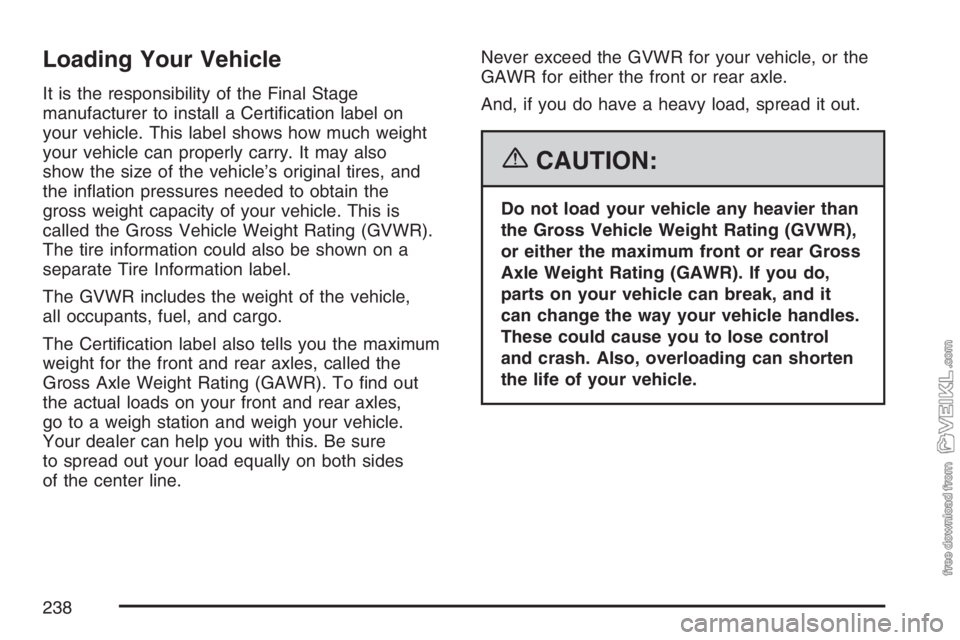
Loading Your Vehicle
It is the responsibility of the Final Stage
manufacturer to install a Certification label on
your vehicle. This label shows how much weight
your vehicle can properly carry. It may also
show the size of the vehicle’s original tires, and
the inflation pressures needed to obtain the
gross weight capacity of your vehicle. This is
called the Gross Vehicle Weight Rating (GVWR).
The tire information could also be shown on a
separate Tire Information label.
The GVWR includes the weight of the vehicle,
all occupants, fuel, and cargo.
The Certification label also tells you the maximum
weight for the front and rear axles, called the
Gross Axle Weight Rating (GAWR). To find out
the actual loads on your front and rear axles,
go to a weigh station and weigh your vehicle.
Your dealer can help you with this. Be sure
to spread out your load equally on both sides
of the center line.Never exceed the GVWR for your vehicle, or the
GAWR for either the front or rear axle.
And, if you do have a heavy load, spread it out.
{CAUTION:
Do not load your vehicle any heavier than
the Gross Vehicle Weight Rating (GVWR),
or either the maximum front or rear Gross
Axle Weight Rating (GAWR). If you do,
parts on your vehicle can break, and it
can change the way your vehicle handles.
These could cause you to lose control
and crash. Also, overloading can shorten
the life of your vehicle.
238
Page 239 of 430
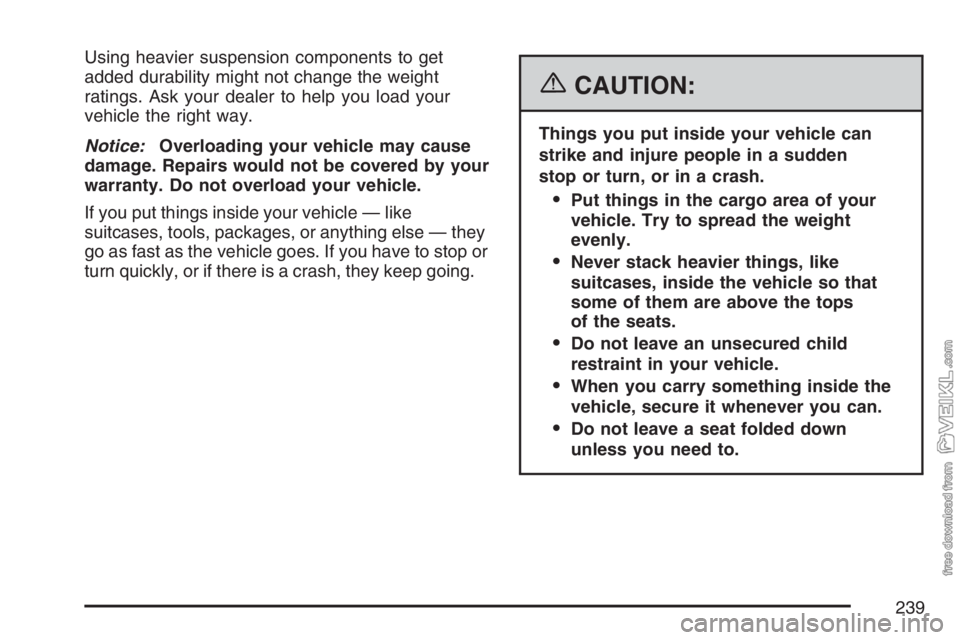
Using heavier suspension components to get
added durability might not change the weight
ratings. Ask your dealer to help you load your
vehicle the right way.
Notice:Overloading your vehicle may cause
damage. Repairs would not be covered by your
warranty. Do not overload your vehicle.
If you put things inside your vehicle — like
suitcases, tools, packages, or anything else — they
go as fast as the vehicle goes. If you have to stop or
turn quickly, or if there is a crash, they keep going.
{CAUTION:
Things you put inside your vehicle can
strike and injure people in a sudden
stop or turn, or in a crash.
Put things in the cargo area of your
vehicle. Try to spread the weight
evenly.
Never stack heavier things, like
suitcases, inside the vehicle so that
some of them are above the tops
of the seats.
Do not leave an unsecured child
restraint in your vehicle.
When you carry something inside the
vehicle, secure it whenever you can.
Do not leave a seat folded down
unless you need to.
239
Page 240 of 430
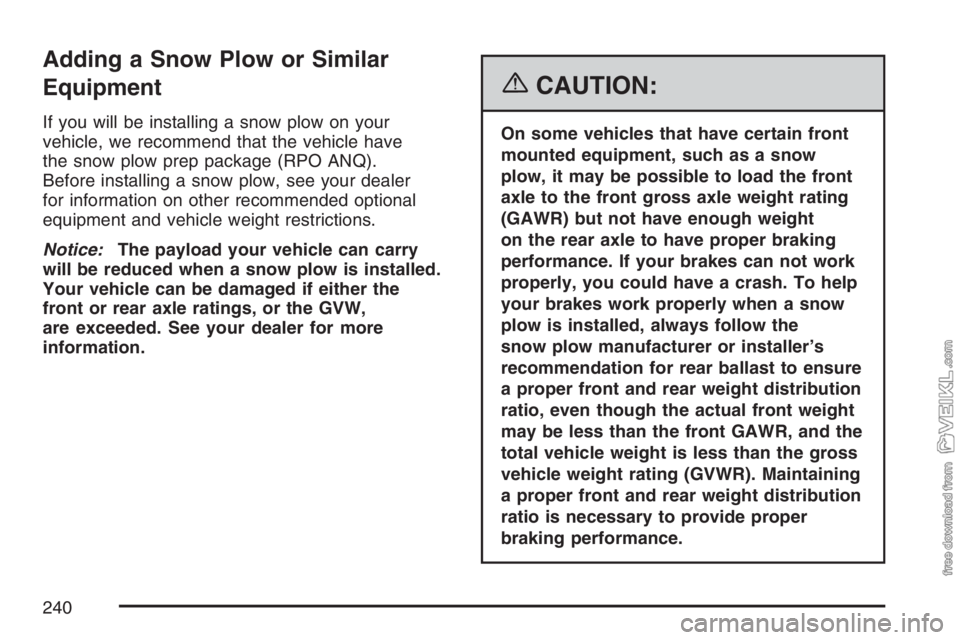
Adding a Snow Plow or Similar
Equipment
If you will be installing a snow plow on your
vehicle, we recommend that the vehicle have
the snow plow prep package (RPO ANQ).
Before installing a snow plow, see your dealer
for information on other recommended optional
equipment and vehicle weight restrictions.
Notice:The payload your vehicle can carry
will be reduced when a snow plow is installed.
Your vehicle can be damaged if either the
front or rear axle ratings, or the GVW,
are exceeded. See your dealer for more
information.
{CAUTION:
On some vehicles that have certain front
mounted equipment, such as a snow
plow, it may be possible to load the front
axle to the front gross axle weight rating
(GAWR) but not have enough weight
on the rear axle to have proper braking
performance. If your brakes can not work
properly, you could have a crash. To help
your brakes work properly when a snow
plow is installed, always follow the
snow plow manufacturer or installer’s
recommendation for rear ballast to ensure
a proper front and rear weight distribution
ratio, even though the actual front weight
may be less than the front GAWR, and the
total vehicle weight is less than the gross
vehicle weight rating (GVWR). Maintaining
a proper front and rear weight distribution
ratio is necessary to provide proper
braking performance.
240